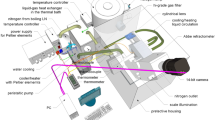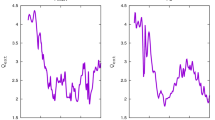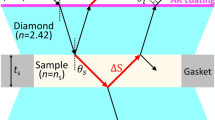Abstract
AN accurate knowledge of the specific refraction increment α, or dn/dC, of proteins is important in measurements which involve the use of the ultra-centrifuge, electrophoresis and light-scattering. Recently, it has become important in connexion with cytological methods of refractometry1 and mass determination2 of living cells. The refraction increment has hitherto usually been measured only at rather low concentrations. The highest concentration reported seems to be by Howard3 in 1920, who found that the variation of refractive index with concentration of hæmoglobin was linear up to about 17 per cent. Armstrong et al. 4 found that α for crystalline serum albumin was constant up to a concentration of 14.6 per cent. Since in cytology considerably higher concentrations may be encountered, and it is well known that the refractive indices of some substances, for example sugars, do not vary quite linearly with concentration, we have measured the refractive indices of bovine serum albumin solutions up to concentrations exceeding 50 per cent. In order to avoid the difficulties associated with the measurement of protein concentrations by dry-weight or nitrogen determinations, we have obtained a factor proportional to the concentration by measuring the optical density at 278 mµ, using a Hilger “Uvispek” ultra-violet spectrophotometer. Deviations from the Beer–Lambert law were avoided by diluting all samples accurately by different amounts to give approximately the same final optical density. The final concentration was about 0.2 per cent in each case, giving optical densities between 1.0 and 1.3 for a 1-cm. path-length.
This is a preview of subscription content, access via your institution
Access options
Subscribe to this journal
Receive 51 print issues and online access
$199.00 per year
only $3.90 per issue
Buy this article
- Purchase on Springer Link
- Instant access to full article PDF
Prices may be subject to local taxes which are calculated during checkout
Similar content being viewed by others
References
Barer, R., Ross, K. F. A., and Tkaczyk, S., Nature, 171, 720 (1953).
Barer, R., Nature, 169, 366 (1952). Davies, H. G., and Wilkins, M. H. F., Nature, 169, 541 (1952). Mitchison, J. M., and Swann, M. M., Quart. J. Micro. Sci., 94, 381 (1953).
Howard, F. H., J. Biol. Chem., 41, 537 (1920).
Armstrong, S. H., Budka, M. J. E., Morrison, K. C., and Hassen, M., J. Amer. Chem. Soc., 69, 1747 (1947).
Cohn, E. J., et al., J. Amer. Chem. Soc., 69, 1753 (1947).
Perlmann, G. E., and Longsworth, L. G., J. Amer. Chem. Soc., 70, 2719 (1948). Halwer, M., et al., J. Amer. Chem. Soc., 73, 2786 (1951).
Robertson, T. B., J. Biol. Chem., 12, 23 (1912).
Author information
Authors and Affiliations
Rights and permissions
About this article
Cite this article
BARER, R., TKACZYK, S. Refractive Index of Concentrated Protein Solutions. Nature 173, 821–822 (1954). https://doi.org/10.1038/173821b0
Issue Date:
DOI: https://doi.org/10.1038/173821b0
This article is cited by
-
Drug screening at single-organoid resolution via bioprinting and interferometry
Nature Communications (2023)
-
Extreme dynamics in a biomolecular condensate
Nature (2023)
-
RNA-mediated demixing transition of low-density condensates
Nature Communications (2023)
-
Highly Sensitive Optofluidic Sensor of 2D Si PhC L3 Cavity for Detection of Glucose and Bovine Serum Albumin
Silicon (2023)
-
Interlaboratory evaluation of a digital holographic microscopy–based assay for label-free in vitro cytotoxicity testing of polymeric nanocarriers
Drug Delivery and Translational Research (2022)
Comments
By submitting a comment you agree to abide by our Terms and Community Guidelines. If you find something abusive or that does not comply with our terms or guidelines please flag it as inappropriate.



